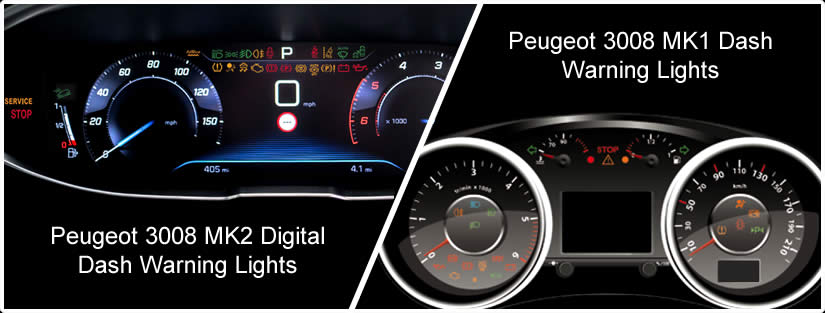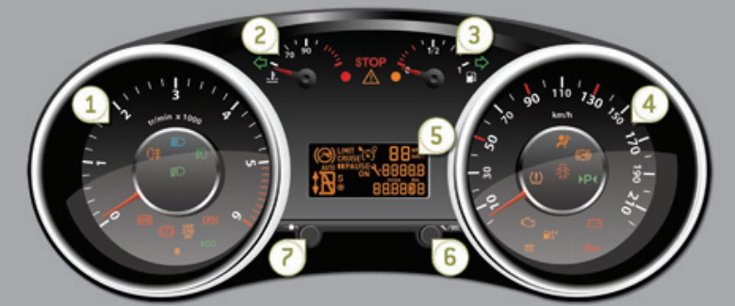Decoding the Peugeot 3008 Warning Lights: A Complete Guide
The Peugeot 3008 is a stylish and sophisticated SUV, packed with technology and safety features. But like any modern vehicle, it relies on a complex system of sensors and electronics to keep everything running smoothly. One of the most critical ways your 3008 communicates with you is through its warning lights. These illuminated symbols on your dashboard act as a silent language, alerting you to potential issues ranging from minor inconveniences to serious mechanical problems. Understanding what these lights mean is crucial for the safety and longevity of your vehicle. This comprehensive guide will help you decode the Peugeot 3008 warning lights, empowering you to take appropriate action and keep your SUV running at its best.
Understanding the Color Code: A Quick Guide
Before diving into specific warning lights, it’s essential to understand the color-coded system used in the Peugeot 3008:
- Red Lights: These are the most critical. They indicate a serious problem that requires immediate attention. Pull over safely as soon as possible and address the issue. Ignoring red lights can lead to severe damage or safety risks.
- Orange/Yellow Lights: These signify a less urgent issue, often indicating a system malfunction or a need for maintenance. Address these as soon as conveniently possible, ideally within a few days.
- Green/Blue Lights: These are typically informational lights, indicating that a system is active or functioning correctly. Examples include headlights, indicators, and cruise control.
Decoding the Common Peugeot 3008 Warning Lights
Let’s break down some of the most common warning lights you’ll encounter in your Peugeot 3008, categorized for clarity:
1. Engine-Related Warning Lights:
- Engine Malfunction Warning Light (Check Engine Light):
- Appearance: Typically an engine-shaped symbol.
- Meaning: Indicates a problem with the engine or its emissions system. Could range from a loose gas cap to a more serious internal issue.
- Action: Have the vehicle diagnosed by a qualified mechanic as soon as possible.
- Oil Pressure Warning Light:
- Appearance: An oil can symbol.
- Meaning: Low oil pressure. This could be due to low oil levels, a faulty oil pump, or another serious issue.
- Action: Immediately pull over safely and turn off the engine. Check the oil level and add oil if necessary. If the light remains on, have the vehicle towed to a mechanic.
- Engine Coolant Temperature Warning Light:
- Appearance: A thermometer symbol, often with wavy lines.
- Meaning: The engine coolant is too hot. This can lead to severe engine damage.
- Action: Pull over safely and turn off the engine. Allow the engine to cool down and check the coolant level. If the light persists, have the vehicle inspected.
- Diesel Particulate Filter (DPF) Warning Light (Diesel Models):
- Appearance: A symbol resembling an exhaust with particles.
- Meaning: The DPF is clogged. This is common in diesel vehicles.
- Action: Drive the vehicle at a consistent speed for a short period to allow the DPF to regenerate (self-clean). If the light remains on, consult your owner’s manual or a mechanic.
2. Brake and Safety System Warning Lights:
- Brake System Warning Light:
- Appearance: An exclamation mark inside a circle, often with parenthesis.
- Meaning: This could indicate a number of issues with the braking system, including low brake fluid, a parking brake that is engaged, or a more serious brake system fault.
- Action: Check the parking brake. If it’s disengaged, the light should disappear. Check brake fluid level. If the light persists, drive cautiously to a mechanic immediately.
- ABS (Anti-lock Braking System) Warning Light:
- Appearance: The letters “ABS” inside a circle.
- Meaning: Indicates a malfunction in the ABS system. While your brakes will still function, the ABS may not.
- Action: Have the ABS system inspected by a mechanic.
- ESP/ASR (Electronic Stability Program/Anti-Slip Regulation) Warning Light:
- Appearance: A car with wavy lines underneath or a car with a triangle and exclamation mark.
- Meaning: Indicates a problem with the ESP or ASR system, which helps with vehicle stability and traction.
- Action: Have the system inspected by a mechanic.
- Airbag Warning Light:
- Appearance: A person seated with a circular airbag in front of them.
- Meaning: Indicates a malfunction in the airbag system. The airbags may not deploy in an accident.
- Action: Have the airbag system inspected by a mechanic immediately.
3. Other Important Warning Lights:
- Battery Charging System Warning Light:
- Appearance: A battery-shaped symbol, often with a plus and minus sign.
- Meaning: Indicates a problem with the charging system, such as a faulty alternator or a discharged battery.
- Action: Have the charging system inspected by a mechanic.
- Power Steering Warning Light:
- Appearance: A steering wheel symbol.
- Meaning: Indicates a problem with the power steering system. Steering may become difficult.
- Action: Have the power steering system inspected by a mechanic.
- Tyre Pressure Monitoring System (TPMS) Warning Light:
- Appearance: An exclamation mark inside a horseshoe shape or a symbol of a tire with an exclamation mark.
- Meaning: Indicates that one or more of your tires has low pressure.
- Action: Check and inflate your tires to the recommended pressure (found on a sticker inside the driver’s side doorjamb). The light may take some time to extinguish after inflation.
- AdBlue® Warning Light (Diesel Models):
- Appearance: A symbol with a fuel pump and a water droplet.
- Meaning: Indicates that the AdBlue® fluid level is low.
- Action: Refill the AdBlue® tank. Your owner’s manual will provide instructions.
Addressing Warning Lights: Steps to Take
When a warning light illuminates, follow these general steps:
- Identify the Light: Note the symbol and its color.
- Consult Your Owner’s Manual: Your owner’s manual is the most comprehensive resource for specific light meanings and recommended actions.
- Assess the Urgency: Red lights demand immediate action. Orange/yellow lights require prompt attention.
- Take Appropriate Action: Follow the recommendations outlined in your owner’s manual.
- Seek Professional Help: If the light persists after taking initial action or if you are unsure, consult a qualified mechanic.
Conclusion
Deciphering the warning lights on your Peugeot 3008 is vital for safe and responsible vehicle ownership. By understanding the meanings of these symbols and knowing how to respond, you can prevent potential problems, extend the life of your vehicle, and ensure the safety of yourself and your passengers. Don’t ignore these important indicators; they are your car’s way of telling you something needs attention. Use this guide as a starting point, and always refer to your owner’s manual for the most accurate and specific information for your Peugeot 3008 model. Regular maintenance and prompt attention to warning lights are key to enjoying your driving experience.
Frequently Asked Questions (FAQs)
1. What should I do if multiple warning lights come on at the same time?
If multiple warning lights illuminate simultaneously, it’s often indicative of a more significant issue. Pull over safely, turn off the engine, and consult your owner’s manual immediately. It’s best to have the vehicle inspected by a mechanic as soon as possible.
2. Can I drive with a warning light on?
It depends on the light. Red lights generally require immediate action and stopping the car. Orange/yellow lights may allow for limited driving, but you should address the issue promptly. Driving with a warning light on can potentially worsen the problem and lead to costly repairs.
3. What if a warning light comes on and then goes off?
If a warning light illuminates and then disappears, it could indicate a temporary glitch or a minor issue. However, it’s still wise to note the light and observe if it reappears. If it does, or if you suspect a problem, have the vehicle checked by a mechanic.
4. How often should I have my Peugeot 3008 serviced?
Refer to your owner’s manual for the recommended service intervals for your specific Peugeot 3008 model. These intervals are typically based on mileage or time (e.g., every 10,000 miles or annually). Following the recommended service schedule is essential for maintaining your vehicle’s performance and reliability.
5. Where can I find more information about my Peugeot 3008’s warning lights?
The best source of information is your Peugeot 3008 owner’s manual. It contains detailed explanations of all warning lights, along with recommended actions and troubleshooting tips. You can also consult a qualified Peugeot mechanic.




